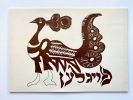Аукцион 17
Books, Holy Books, Wine, Records, Maps, Judaica, Israeliana, Collectables
от Fantiquario
Контакты аукционного дома
23.3.21
Palmach 12, Jerusalem, Израиль
Условия участия
Демо
Аукцион закончен
|
ЛОТ 371:
Soviet Yiddish writers 1917-1923. Portfolio with 9 facsimile booklets - Limited Edition of 500 copies - Copy No. ...
далее...
|
|























|
Продан за: $100 (₪330)
Цена с учетом комиссии и НДС:
$
123,60 (₪407,88)
Рассчитывается по курсу, установленному аукционным домом в день аукциона
Стартовая цена:
$
100
Комиссия аукционного дома: 20%
Далее
НДС: 18%
Только на комиссию
|
Soviet Yiddish writers 1917-1923. Portfolio with 9 facsimile booklets - Limited Edition of 500 copies - Copy No. 39. Issued by The Jewish National and University Library to mark the 30 anniversary of the execution of Yiddish writers in USSR.
1. David Bergelson (1884–1952), Mayse-Bikhl, with illustrations – lithographs and woodcuts – by Lasar Segall, a Jewish painter, engraver and sculptor, born in Vilnius. . Berlin: Wostok, 1923. Super Octavo. 8 3/4 x 10 1/4"; 220 x260 mm. 38 pages. softcover with illustrated DJ.
2. Yeheskel Dobrushin (1883-1952?), Farnakhtn (1911-1914), Kiev 1917. Octavo. 7x7"; 180 x 180 mm. 60 pages. softcover with DJ.
3. Shmuel Halkin (1897-1960), Lider, Kiev: Literaten Farlag, 1922. Sextodecimo. 4 3/4 x 7"; 120x180 mm. 60 pages. softcover with DJ.
4. David Hofstein (1889–1952), Troyer [Sorrow], Kiev: Kultur Lige, 1922. Illustrations by Marc Chagall. Quarto, 9 1/2 x 13"; 240 x 330 mm. 23 pages. softcover with DJ. A poetry cycle by David Hofstein dealing with the pogroms against Ukrainian Jews during the years 1917-1920; accompanied by a series of illustrations by Marc Chagall. The book was published with the support of the "Public Jewish Committee for Assisting Victims of War, Riots and Natural Disasters" and it states: "All profits go to the starving Jewish colonies".The illustration of Hofstein's cycle of poems was one of Chagall's last projects before leaving Russia.
5. Peretz Markish (1895-1952), Die Kupe ("The Heap"), Kiev:1922 (Poem about the pogroms in the Ukraine). Composition on title page by Henrik Barlevi. Quarto, 9 1/2 x 13"; 240 x 330 mm. 32 pages. softcover with DJ.
6. Pinchus Kahanovich ("Der Nister") (1884-1950), A Mayse mit a hon; Dos tsigele [A Story About a Rooster and The Little Kid]. Petrograd: Vilner farlag fun B.A. Kletzin, 1917. , 8 illustrations by Marc Chagall. The first Yiddish book, and the only children's book to be illustrated by the great modern artist. Octavo. 4 3/4 x 6 1/2"; 120x165 mm. 30 pages. softcover with DJ.
7. Leib Kvitko (1890–1952), "Foyglen" – Illustrations by Issachar Ber Ryback, Berlin: Schwellen, [ca.1922]. Oblong. 9 1/2 x 13 1/4"; 240 x 340 mm. 15 pages. softcover with DJ.
8. Aaron Kushnirov (1890-1949) Vent("Walls, ") Kiev: 1921. Octavo. 4 3/4 x 6 1/2"; 120x165 mm. 37 pages. softcover with DJ.
9. Itzik Kipnis (1896-1974) Oksn ("Oxen") Kiev: 1923. Octavo. 4 3/4 x 6 1/2"; 120x165 mm. 23 pages. softcover with DJ.
Each booklet numbered copy No. 39 and Exlibris of Reuven Yaron.
The Night of the Murdered Poets was the execution of thirteen Soviet Jews in the Lubyanka Prison in Moscow, Russian SFSR, Soviet Union on 12 August 1952. The arrests were first made in September 1948 and June 1949. All defendants were falsely accused of espionage and treason as well as many other crimes. After their arrests, they were tortured, beaten, and isolated for three years before being formally charged. There were five Yiddish writers among these defendants, all of whom were part of the Jewish Anti-Fascist Committee.
The trial began on 8 May 1952 and lasted until the sentencing on 18 July. The structure of the trial was peculiar due to the fact that there were no prosecutors or defence attorneys, simply three military judges. This was in accordance with Soviet law at the time, but is characterized by historians today as "nothing less than terror masquerading as law." While some defendants admitted their guilt, others plead partially guilty and some maintained their innocence. Since the trial was not public, the defendants made expressive and often lengthy statements professing their innocence. The defendants also had the opportunity to cross-examine each other, furthering the trial's intense atmosphere. During the trial, defendants answered some questions from judges which were wholly unrelated to the trial and resulted merely from personal curiosities. For example, the judges often asked the defendants about kosher meat and synagogue services.With extensive statements, arguments, and inconsistencies between the defendants, the trial lasted much longer than the government had desired. On 26 June, experts were called to give testimony about the issues of treason, but they ultimately acknowledged that "their judgment was incomplete and insufficient." It became clear that some pieces of evidence had been tremendously exaggerated. For example, a statement by Leon Talmy that a particular Russian village was "not as pretty" as a certain Kan village was used as evidence of his nationalist tendencies. Alexander Cheptsov, the lead judge of the trial, confronted with such a great number of discrepancies and contradictions, twice made attempts to appeal to the Soviet leadership to reopen the investigation and was denied both times. Even after sentencing the defendants, Cheptsov attempted to lengthen the process by declining to immediately execute the defendants. (wikipedia)

